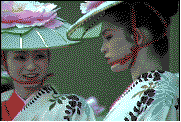The country was started appearing as an organized country 1500 years ago. As you guess, it had been influenced by the neighbors like China and Korea. In the same time, Japan had developed their original style for their culture and custom, because the country is an island country separated from the continent.
They have an original religion, Shinto. It was established a long time ago, and then it became more than a religion. It exists here and there in Japan as culture and custom of the living life. Japanese emperor is an important figure of the religion.
Samurai dominated the country between early 11th century and early 20th century. During the period, different powerful samurai groups governed the large part of the country with the status, “Shogun”, licensed by emperors. However, it was very difficult to control the entire country, so the power balance of samurai groups were instable time to time. Only one shogun family, Tokugawa, could hold its power over all country between 16th century and mid 19th century.
In 1868 the long samurai dominance was ended, because of the pressure from European countries. Some samurai groups with advanced thought took over the sovereignty under the emperor and westernized the style and system of Japan drastically and quickly.
The transformation from medieval to modern was successful. Even though it went through the painful experience of WWII, the county has been one of advanced countries since late 19th century.
Welcome to "Clues on Japan"
Thank you for visiting the site. If you come from my old site, welcome back. I restarted the blog site, because the old one limited the subject from the title, "Travel to Japan." Some people can't go there or don't want to go there physically but want to know about Japan. So, I opened the plate wider for anyone who get any interest in Japan on any level. For the start of the new site, I want to put the old postings for new visitors. So, if you already went though them, please be patient for new posting.
Thursday, November 16, 2006
Subscribe to:
Post Comments (Atom)

No comments:
Post a Comment